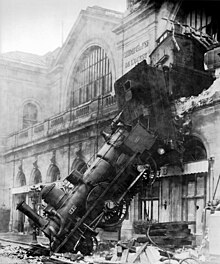It has been suggested that this article be merged with Classification of railway accidents . (Discuss) Proposed since January 2025. |



A train accident or train wreck is a type of disaster involving one or more trains. Train wrecks often occur as a result of miscommunication, as when a moving train meets another train on the same track, when the wheels of train come off the track or when a boiler explosion occurs. Train accidents have often been widely covered in popular media and in folklore.
Contents
A head-on collision between two trains is colloquially called a "cornfield meet" in the United States. [1]
